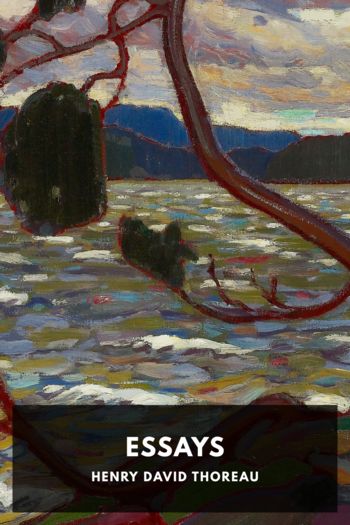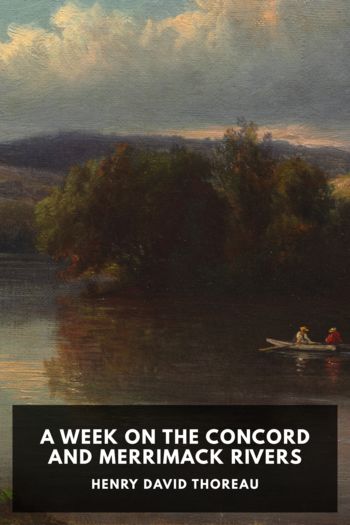Essays by Henry David Thoreau (feel good books .txt) 📕

Description
Though perhaps most famous for Walden, Henry David Thoreau was also a prolific essayist. Many of his essays touch on subjects similar to his famous book: long walks through nature, things found in moonlight that are invisible and unheard during the day, his preference for wild apples over domestic ones. In many ways he prefigured environmentalism, expressing his love for untouched nature and lamenting what the encroachment of man and cities were doing to it.
He also had strong opinions on many other subjects. One of his most famous essays, “On the Duty of Civil Disobedience,” was written as a result of his going to jail for refusing to pay several years’ worth of poll taxes. One of the primary reasons for his refusal was his holding the government in contempt for its support of slavery, and several of his other essays express support and admiration for John Brown, who thought to start a slave revolt when he attacked Harper’s Ferry in 1859.
Whether discussing trees in a forest, slavery, or the works of Thomas Carlyle, Thoreau’s essays are deeply personal and full of keen observations, often in poetic language. They give a sense of the man expressing them as being much more than the views being expressed.
Read free book «Essays by Henry David Thoreau (feel good books .txt) 📕» - read online or download for free at americanlibrarybooks.com
- Author: Henry David Thoreau
Read book online «Essays by Henry David Thoreau (feel good books .txt) 📕». Author - Henry David Thoreau
The heavy rain confining us to the saloon awhile, I discoursed with the proprietor of Sugar Island on the condition of the world in Old Testament times. But at length, leaving this subject as fresh as we found it, he told me that he had lived about this lake twenty or thirty years, and yet had not been to the head of it for twenty-one years. He faces the other way. The explorers had a fine new birch on board, larger than ours, in which they had come up the Piscataquis from Howland, and they had had several messes of trout already. They were going to the neighborhood of Eagle and Chamberlain lakes, or the headwaters of the St. John, and offered to keep us company as far as we went. The lake today was rougher than I found the ocean, either going or returning, and Joe remarked that it would swamp his birch. Off Lily Bay it is a dozen miles wide, but it is much broken by islands. The scenery is not merely wild, but varied and interesting; mountains were seen, farther or nearer, on all sides but the northwest, their summits now lost in the clouds; but Mount Kineo is the principal feature of the lake, and more exclusively belongs to it. After leaving Greenville, at the foot, which is the nucleus of a town some eight or ten years old, you see but three or four houses for the whole length of the lake, or about forty miles, three of them the public houses at which the steamer is advertised to stop, and the shore is an unbroken wilderness. The prevailing wood seemed to be spruce, fir, birch, and rock maple. You could easily distinguish the hard wood from the soft, or “black growth,” as it is called, at a great distance, the former being smooth, round-topped, and light green, with a bowery and cultivated look.
Mount Kineo, at which the boat touched, is a peninsula with a narrow neck, about midway the lake on the east side. The celebrated precipice is on the east or land side of this, and is so high and perpendicular that you can jump from the top, many hundred feet, into the water, which makes up behind the point. A man on board told us that an anchor had been sunk ninety fathoms at its base before reaching bottom! Probably it will be discovered ere long that some Indian maiden jumped off it for love once, for true love never could have found a path more to its mind. We passed quite close to the rock here, since it is a very bold shore, and I observed marks of a rise of four or five feet on it. The St. Francis Indian expected to take in his boy here, but he was not at the landing. The father’s sharp eyes, however, detected a canoe with his boy in it far away under the mountain, though no one else could see it. “Where is the canoe?” asked the captain, “I don’t see it”; but he held on, nevertheless, and by and by it hove in sight.
We reached the head of the lake about noon. The weather had, in the meanwhile, cleared up, though the mountains were still capped with clouds. Seen from this point, Mount Kineo, and two other allied mountains ranging with it northeasterly, presented a very strong family likeness, as if all cast in one mould. The steamer here approached a long pier projecting from the northern wilderness, and built of some of its logs, and whistled, where not a cabin nor a mortal was to be seen. The shore was quite low, with flat rocks on it, overhung with black ash, arborvitae, etc., which at first looked as if they did not care a whistle for us. There was not a single cabman to cry “Coach!” or inveigle us to the United States Hotel. At length a Mr. Hinckley, who has a camp at the other end of the “carry,” appeared with a truck drawn by an ox and a horse over a rude log-railway through the woods. The next thing was to get our canoe and effects over the carry from this lake, one of the heads of the Kennebec, into the Penobscot River. This railway from the lake to the river occupied the middle of a clearing two or three rods wide and perfectly straight through the forest. We walked across while our baggage was drawn behind. My companion went ahead to be ready for partridges, while I followed, looking at the plants.
This was an interesting botanical locality for one coming from the south to commence with; for many plants which are rather rare, and one or two which are not found at all, in the eastern part of Massachusetts, grew abundantly between the rails—as Labrador-tea, Kalmia glauca, Canada blueberry (which was still in fruit, and a second time in bloom), Clintonia and Linnaea borealis, which last a lumberer called moxon, creeping snowberry, painted trillium, large-flowered bellwort, etc. I fancied that the Aster Radula, Diplopappus umbellatus, Solidago lanceolata, red trumpet-weed, and many others which were conspicuously in bloom on the shore of the lake and on the carry, had a peculiarly wild and primitive look there. The spruce and fir trees crowded to the track on each side to welcome us, the arborvitae, with its changing leaves, prompted us to make haste, and the sight of the canoe birch gave us spirits to do so. Sometimes an evergreen just fallen lay across the track with its rich burden of cones, looking, still, fuller of life than our trees in the most favorable positions. You did not expect to find such spruce trees in the wild woods, but they evidently attend to their toilets





Comments (0)